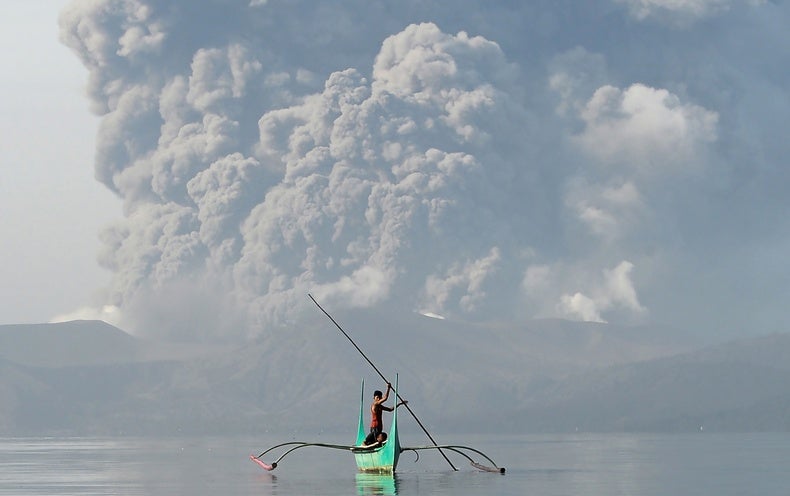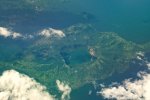Heliobas Disciple
TB Fanatic
(fair use applies)
Alert level raised in the Philippines as Taal Volcano erupts, prompts evacuations
By Renee Duff, AccuWeather meteorologist
Updated jan. 12, 2020 3:18 AM
The Taal Volcano in the central Philippines rumbled to life on Sunday, spewing ash and prompting evacuations in nearby communities. The volcano is located on the island of Luzon and is the country's second most active volcano.
The Philippine Institute of Volcanology and Seismology (PHIVOLCS) raised the status of the Taal Volcano from Alert Level 1 to Alert Level 2 at 2:30 p.m. Sunday, local time, indicating a moderate level of volcanic unrest. This was upgraded less than two hours later to an Alert Level 3, indicating a high level of volcanic unrest. The alert system has five levels with Alert Level 5 meaning a hazardous eruption is in progress.
"Taal Volcano Main Crater has escalated its eruptive activity, generating an eruption plume 1 km [3,280 feet] high accompanied by volcanic tremor and felt earthquakes in Volcano Island and barangays of Agoncillo, Batanga. Ashfall is currently being showered on the southwest sector of Taal," PHIVOLCS said in a statement.
"The public is reminded that the Main Crater should be strictly off-limits because sudden steam explosions can occur and high concentrations of lethal volcanic gases can be released," they added. "In addition, communities around the Taal Lake shore are advised to take precautionary measures and be vigilant of possible lakewater disturbances related to the ongoing unrest."
Evacuations are underway for an unknown number of people in the municipalities of San Nicolas, Balete and Talisay, according to The Philippine Star.
"A seismic swarm has started at around 11:00 a.m. and ongoing as of 2:10 p.m.," PHIVOLCS said.
The last major eruption of the Taal Volcano occurred in 1977.
Alert level raised in the Philippines as Taal Volcano erupts, prompts evacuations
By Renee Duff, AccuWeather meteorologist
Updated jan. 12, 2020 3:18 AM
The Taal Volcano in the central Philippines rumbled to life on Sunday, spewing ash and prompting evacuations in nearby communities. The volcano is located on the island of Luzon and is the country's second most active volcano.
The Philippine Institute of Volcanology and Seismology (PHIVOLCS) raised the status of the Taal Volcano from Alert Level 1 to Alert Level 2 at 2:30 p.m. Sunday, local time, indicating a moderate level of volcanic unrest. This was upgraded less than two hours later to an Alert Level 3, indicating a high level of volcanic unrest. The alert system has five levels with Alert Level 5 meaning a hazardous eruption is in progress.
"Taal Volcano Main Crater has escalated its eruptive activity, generating an eruption plume 1 km [3,280 feet] high accompanied by volcanic tremor and felt earthquakes in Volcano Island and barangays of Agoncillo, Batanga. Ashfall is currently being showered on the southwest sector of Taal," PHIVOLCS said in a statement.
"The public is reminded that the Main Crater should be strictly off-limits because sudden steam explosions can occur and high concentrations of lethal volcanic gases can be released," they added. "In addition, communities around the Taal Lake shore are advised to take precautionary measures and be vigilant of possible lakewater disturbances related to the ongoing unrest."
Cameras monitoring the volcano caught ash spewing from the crater around the midday hours of Sunday.Ongoing phreatic explosion at the Main Crater of Taal Volcano. Photos taken from installed IP camera monitoring the activity of Taal Volcano. pic.twitter.com/9Qyd7aLvsJ
— PHIVOLCS-DOST (@phivolcs_dost) January 12, 2020
Evacuations are underway for an unknown number of people in the municipalities of San Nicolas, Balete and Talisay, according to The Philippine Star.
A moderate to high level of seismic activity has been observed in the vicinity since March 28, 2019, according to PHIVOLCS. The agency reported three earthquake events as of early Sunday afternoon.JUST IN: Taal Volcano erupts on Sunday afternoon. | Video courtesy of Veronica Mercado pic.twitter.com/uWEYlVJ94j
— The Philippine Star (@PhilippineStar) January 12, 2020
"A seismic swarm has started at around 11:00 a.m. and ongoing as of 2:10 p.m.," PHIVOLCS said.
The last major eruption of the Taal Volcano occurred in 1977.
Last edited:





